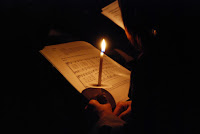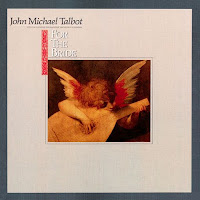
[[Hi Sister, I was reading blogs by hermits and came across one mentioning watching a video of your profession. A few days later the blogger wrote the following. [[For a non-canonical, privately avowed . . .hermit, all else remains the same. One must provide for oneself. This may include having a job. Many receive pensions or are on disability. . .the hermit may get a part-time job that is pleasant and positive but creative yet mindless. This allows for praying on the job, and pondering. Plus, it provides some human contact. Some hermits need more than others. God allows.]] I guess I was surprised by the description of the work hermits are called to do as "creative but mindless". It gives the impression of trivial work that is not prayer but doesn't get in the way of prayer, or at least doesn't get in the way of saying prayers. So my question is since hermits need to work how do they choose work? Is it really mindless work? I wonder is this blogger's description of hermit work strikes you as it did me --- a kind of busyness for which one is paid even though it is of no value. Thanks.]]
Hi there yourself, and thanks for the questions and comments.
My perpetual eremitical profession was more than 8 years ago so that is a pretty old blog piece! While I too find the use of the term mindless offensive and, more importantly, contrary to the nature of the work of any genuine contemplative, I suspect what this person was trying to say was that the work should be consonant with prayer and not so taxing as to distract from that or debilitate one's spiritual focus in some significant way. I suspect she was thinking of something like gardening or candy making or labeling jars of honey or something similar --- occupations of whatever sort which allow one to work while relatively relaxed mentally. However, what she actually said was something else. Can you conceive of any genuinely creative work that is mindless? How about work which requires one's full attention, body, mind, and spirit? In any case I consider this an unfortunate and probably mistaken choice of words, but whether that is so or not, I disagree that it describes eremitical life or even something that is desirable in contemplative and/or eremitical life.+

Hermits work in part to support themselves and/or their congre-gations. They work too because work has inherent dignity and is one way a hermit engages constructively with the world God created and the future God is bringing to be. That is true whether we are speaking of manual labor or intellectual labor. It is true whether the work is mechanized, routinized, or is very much more individual than this. And of course they work in order to make a contribution, not only to their own brothers or sisters, but to society and the Church as a whole. While I can't say exactly how hermits choose their work beyond generalities of need, talents, and interest, I do not know any hermits who engage in "make-work" kinds of activities with no real value. Some of us are disabled and even in such circumstances we do what we can to be responsible to others and to model healthy ways of being sick in the Church, which, as I recently wrote, is a very different thing than being sick outside the faith community. That may not mean much physically demanding work, but it will mean a routine in which we care for ourselves and our hermitages, perhaps a little work in our gardens where new life is nurtured and we are enabled to get a bit of sun and light (or not so light!) exercise, and for some of us, some intellectual work which may, whether now or one day, be useful to the Church and world.
The point is that the life of faith is a whole-hearted whole-person journey. Everything the hermit undertakes is dignified by her life with God. Ideally at least, she does nothing alone and because that is the case she does nothing without value. Because God is implicated in the whole of her life, the whole of her life possesses a profound incarnational or sacramental significance. At this Advent-Christmas transition we have to be aware that whenever we open our minds and hearts to the God who would dwell fully within us we become more and more the imago dei we are made to be just as it allows God to be more fully the God he wills to be. What is not allowed, of course, is 'mindlessness'. The real work we actually do is precisely the work of mindfulness. Mindlessness closes us off to God and to the real engagement we know variously as compassion, worship, prayer, hope, love, and faith. Whether intellectual, physical, or spiritual work, it is mindfulness and especially mindfulness at the service of Love-in-Act that transforms this into the work of a contemplative. But again, under no circumstances is the "presencelessness" and personal disengagement of mindlessness an attribute of contemplative life.
Recreation and Absorbing Tasks as Medium for Prayer:

This is not to say one cannot become absorbed in some profoundly enjoyable or recreational activity. Quite the contrary. For instance, I sometimes have tried my hand at drawing. Recently I drew two black and white pencil pictures of Mary and Joseph with their new baby and manger surrounded by sheep, shepherds, and even a lion. In one (still unfinished) I have the beginnings of a camel (I have never drawn any of these animals before and they are each a bit childish and experimental). The drawings could be used for Christmas cards but that was not the point. While the work was not mindless, it was absorbing, relaxing, recreational in the best sense of that word and at the same time allowed me to think and pray about Christmas and enter Advent more fully. Some of the reflecting I did recently about Joseph was done while drawing the Mary and Joseph figures and it was done in a very unself-conscious kind of way. My attention was on the struggle with lines and shapes and proportions, with how one draws the face, mane, and then the cat-like paws of a resting lion so that one captures peace without robbing him of power, or the spindly legs and wooly coat of the sheep, and so forth.
A lot of the time I thought I was mainly being educated on the ways flowing garments can hide an artist's ineptitude in dealing with anatomical complexities --- though there was a lot in all that about humility as well. But underneath all that I was thinking in some way about Friday's readings: about the human struggle underlying and eventuating in this idyllic scene and the divine and cosmic drama it reflected. I was struggling to do justice to this nativity tableau and capture something of the future breaking in on us in a proleptic way. I suspect this activity is one of the main sources of my sense that Joseph was an icon of the struggle to do and bring justice to birth. I know it reminded me of entering those liminal spaces where God can speak to us and make Godself known. I am not sure what words fit best in all of this besides unself-conscious but certainly "mindless" does not work at all; I think the blogger you cited, despite what she actually wrote, was aware of the same thing.
Saying Prayers vs Praying:

One topic you raise which is very good indeed is the insight that the blogger seems to be speaking of doing some mindless job so that she may pray at the same time. I think your comments indicate an implicit criticism of such a notion and if so, I agree completely. It is one thing to make a prayer of one's work; while this notion can be distorted and abused by those really resisting praying it is more than possible. Indeed, it is desirable and we have to allow God to transfigure our activity into prayer. I think my description of what occurred during my drawing sessions is an example of something becoming prayer. But I wasn't busy trying to draw and say prayers. That would, or at least could well indicate a divided mind, a kind of multi-tasking in which neither task gets one's full attention. I think we have to watch out for that kind of thing. In any case, the reference you have cited says nothing about saying prayers. She refers to praying and pondering so I will say I believe she is describing the same thing I did with my images of drawing sessions and it is all made unclear by her misspeaking with the word mindless.
 Only you can determine whether what you are describing is normal introversion or something more than that which needs, at least to some extent, to be corrected, modified or healed. I would encourage you to pray about it and talk to someone who understands the need for solitude in any life but who also understands our need for others and loving others. Introverts or no we are all communal beings. The ability to balance these two dimensions of our lives takes some work! I think that will be especially true for you precisely because you are married and work full time outside a hermitage.
Only you can determine whether what you are describing is normal introversion or something more than that which needs, at least to some extent, to be corrected, modified or healed. I would encourage you to pray about it and talk to someone who understands the need for solitude in any life but who also understands our need for others and loving others. Introverts or no we are all communal beings. The ability to balance these two dimensions of our lives takes some work! I think that will be especially true for you precisely because you are married and work full time outside a hermitage.























.jpg)























